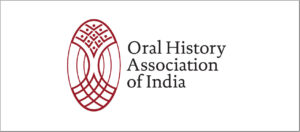
Fourth Oral History Association of Indian (OHAI) Conference Call for Papers
Ambedkar University, Delhi, February 1-2, 2019
Community, Place and Identity: Possibilities of Oral History (for more information https://ohaindia.wordpress.com/upcomingevents/)
Call for Papers
In Oral History, the purpose is often to “give voice” to marginal or forgotten individuals or groups, to listen to their stories and give them the possibility to speak from their perspectives (Thompson, 2000). Yet oral history is not simply someone telling a story; it is someone telling a story in response to the particular queries of another. The exchange is historical in intent, an “in-depth” inquiry that seeks information about and insights into the past from the perspective of the narrator. Being an interpretation of the past, oral history recognizes an element of subjectivity, and itself requires interpretation for it’s meaning to be understood, a possibility that has expanded even as narratives and sources of oral history become increasingly accessibility in a variety of online formats.
The Fourth OHAI Conference focuses on intersections between Community, Place and Identity, when seen from many ‘other’ perspectives. The Conference calls for Papers and Presentations that examine how in a world increasingly mobile and interconnected, groups and individuals redefine pasts and connect to the present, negotiate their own identities or construct it for others. In the urbanising world of today, this becomes increasingly widespread, as the urban allows the disappearance of certain kinds of structures, even as it introduces others.
The Conference welcomes papers that deconstruct oral history narratives, and so open new explorations while looking at intersections of categories like class, ethnicity, status, nation, place, religion and gender. Place is space made culturally meaningful, as anthropologists and human geographers would indicate. For example, working with concepts like intersectionality and narrated identity allow an investigation of the interweaving and dependence of social categories that both teller and listener use. In a broader frame, the conference hopes such deconstructions will draw attention to interesting and unexpected assumptions made about multi-dimensional identity constructions.
We hope that conference papers and presentations will explore how construction, narration and negotiation of own and other identities as seen in relation to different situations, contexts and interviewers. A sense of space and time together create the meanings invested by people about the place they occupy, elaborating sociospatial relations of community that account for both instrumental and communicative rationality, when dealing with collective identity and collective action.
Themes
- Reclaiming space and politics of narrated identities
- Negotiating space: Analysing gender (including LGBT) / caste/ race
- Migration and displacement
- Memory and resistance
- Displacement and imagined homelands
- Communities, Traditions and Heritage Sites
- Urban Narratives : Neighourhood, identity and the everyday.
- Urban oral histories – place making and community
Important Dates:
- Submission of abstract: 7th November
- Selection of abstracts: 15th November
- Submission of Papers: 30th December
- Conference Dates: Friday 1st February & Saturday 2nd February 2019
Abstract submission guidelines
Size in words: 150 – 250
The abstract should be sent to: oralhistoryindia@gmail.com on or before the abstract submission deadline mentioned above.
Paper submission guidelines
Size in words: 5,000 – 7,000
- TITLE (Font-14, Bold, Times New Roman); SUB-TITLE (Font-14, Times New Roman)
- Author’s name with designation, e.g., Dr., Prof. Ms., Mr. (Font-12, Bold, Times New Roman)
- Affiliation with Institute Name, University, City, Country, Email ID (Font-12, Italic, Times New Roman, spacing 1.0)
- Headings (Font-12, Bold, Times New Roman)
- Sub Heading (Font-12, bold, Times New Roman)
- If there are any points to explain then bullet should be used, Style should be Document bullets – Times New Roman, Font size-12
- Figure/Table no. and title should be above the diagram. (Times New Roman, 12, Italic, Centre Align)
- Name or save your paper indicating your name: e.g. Surname_First name_Middle name_paper.doc
- Any tables or figures must be numbered and have captions at the bottom.
Referencing style
- Harvard-style referencing should be used throughout the paper.
- The Harvard referencing system includes the author, the date of the work and the page number in brackets in the body of the text, immediately following the quote or reference. For example:
Depending on a company’s goals, there are a variety of reasons top management may decide to undertake cost controls; it could be for proven cost reduction (Corbridge, 1998, p.27) or to “improve corporate image in the environmental area” (Bozena, et al, 2003, p.45).
- In the Harvard style, a bibliography of the all references is included as a separate section at the end of the document giving full details of author(s) last name, First name(s) and year of publication, followed by the source and the publisher and place of publication.
- References should be listed in alphabetical order and all lines other than the first line should be indented.
